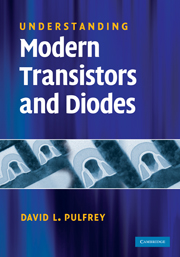Book contents
- Frontmatter
- Contents
- Preface
- 1 Introduction
- 2 Energy band basics
- 3 Electron and hole concentrations
- 4 Thermal equilibrium
- 5 Charge transport
- 6 np- and Np-junction basics
- 7 Solar cells
- 8 Light-emitting diodes
- 9 HBT basics
- 10 MOSFET basics
- 11 HJFET basics
- 12 Transistor capacitances
- 13 Transistors for high-speed logic
- 14 Transistors for high frequencies
- 15 Transistors for memories
- 16 Transistors for high power
- 17 Transistors for low noise
- 18 Transistors for the future
- Appendices
- Index
8 - Light-emitting diodes
Published online by Cambridge University Press: 05 June 2012
- Frontmatter
- Contents
- Preface
- 1 Introduction
- 2 Energy band basics
- 3 Electron and hole concentrations
- 4 Thermal equilibrium
- 5 Charge transport
- 6 np- and Np-junction basics
- 7 Solar cells
- 8 Light-emitting diodes
- 9 HBT basics
- 10 MOSFET basics
- 11 HJFET basics
- 12 Transistor capacitances
- 13 Transistors for high-speed logic
- 14 Transistors for high frequencies
- 15 Transistors for memories
- 16 Transistors for high power
- 17 Transistors for low noise
- 18 Transistors for the future
- Appendices
- Index
Summary
The light-emitting diode (LED) is a pn-junction diode in which radiative recombination is encouraged to occur under forward-bias operating conditions. Thus, there is conversion of electrical energy to optical energy. In essence, the LED is the complement of the solar cell. In the example shown in Fig. 8.1, the internally generated photons escape through the top surface, which cannot, therefore, be covered entirely by the top metallic contact.
In the first part of this chapter, we develop an understanding of the LED by considering a number of efficiencies that relate to the various stages of the conversion of electrical energy to optical energy:
voltage efficiency. This relates the applied voltage to the bandgap of the semiconductor. The latter would be chosen to obtain the desired colour of emitted light;
current efficiency. This relates the current due to recombination in the desired part of the device to the current due to recombination elsewhere. Consideration of this efficiency leads to the heterostructural design that is a feature of modern, high-brightness LEDs;
radiative efficiency. This relates to the relative amounts of radiative recombination and unwanted, non-radiative radiation. It leads to material selection (direct bandgap), and specifications on doping and purity;
extraction efficiency. This relates to getting the photons out of the semiconductor in which they are generated. Consideration of this efficiency largely determines the substrate, contacts, and, in some cases, the shape of the device.
[…]
- Type
- Chapter
- Information
- Understanding Modern Transistors and Diodes , pp. 138 - 152Publisher: Cambridge University PressPrint publication year: 2010
- 1
- Cited by



